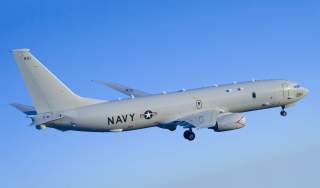Look Closely: This U.S. Navy Patrol Plane Is Looking More and More Like a Bomber
The U.S. Navy wants to arm its Boeing P-8 Poseidon patrol planes with new anti-ship missiles plus precision-guided bombs, mines and aerial decoys.
The U.S. Navy wants to arm its Boeing P-8 Poseidon patrol planes with new anti-ship missiles plus precision-guided bombs, mines and aerial decoys.
If the fleet follows through on the plan, the Navy will acquire its first new bomber aircraft in generations. The last A-6 bombers left the fleet in the late 1990s.
The jet-propelled P-8, which rapidly is replacing older, propellor-driven P-3s in Navy squadrons, already carries anti-submarine torpedoes, Harpoon anti-ship missiles and Standoff Land-Attack Missiles Expanded Response, or SLAM-ERs
But now the Navy wants to add Long-Range Anti-Ship Missiles, Joint Direct Attack Munitions, Small-Diameter Bombs, Mark 62/63/65 mines and Miniature Air-Launched Decoys. The fleet announced the addition in a February 2020 solicitation to industry.
The new weapons greatly would expand the kinds of targets the P-8 can attack. The Poseidon is a modified 737NG airliner with a new wing, military sensors and communications as well as an internal weapons bay and wing pylons for munitions.
With its current loadout, the P-8 can strike ships and land targets more than 150 miles away plus submarines at shorter distances. Adding LRASM would extend the Poseidon’s striking range to greater than 200 miles for sea targets.
JDAM and SDB, while more limited in range than SLAM-ER is, would give P-8 crews the option of striking coastal installations and supporting ground troops in lightly-defended air space. The addition of an air-launched decoy could improve the P-8’s survivability against enemy air-defenses.
But adding these new munitions doesn’t necessarily alter the P-8’s role. The Navy uses its planned fleet of at least 177 Poseidons for maritime patrol, anti-submarine warfare, anti-ship strikes and over-land surveillance using a secretive, underslung radar.
The APS-154 Littoral Surveillance Radar System transforms the P-8 into a surface-surveillance platform similar to the U.S. Air Force's E-8 radar plane.
U.S. Navy P-8s were part of NATO’s response after Russia in October 2019 sortied eight submarines at one time into into the cold waters of the Barents and Norwegian Seas.
Between Oct. 25 and Nov. 7, 2019, the NATO planes flew more than 40 missions. Six Norwegian air force P-3s, four U.S. Navy P-8s and a Canadian air force CP-140 flew from Andoya in Norway. At least one additional P-8 flew from Keflavik in Iceland. A French navy Atlantic 2 patroller staged from Prestwick airport in Scotland.
Flight-trackers followed the patrol planes as they flew hundreds of miles into the North Atlantic to fly racetrack patterns over the apparent locations of Russian submarines. The patrol planes use their radars, sonar buoys and magnetic detectors to find subs on and below the waves.
The U.S. fleet has not developed tactics for employing the P-8 as a true bomber. Nor is the relatively lightly-built P-8 necessarily suited for hard flying in dangerous environments. In adding new munitions, the Navy could make the P-8 better at what it already does.
And in a way, the fleet simply is replacing existing capabilities. The patrol version of the P-3, which has served since the 1960s, is on schedule to leave the fleet in 2023. The Navy over the decades has added a wide range of weapons to the P-3 including torpedoes, anti-ship and land-attack missiles, unguided rockets, cluster bombs and even Maverick anti-tank missiles.
Other countries have planned or completed similar modifications to their maritime patrol planes. The Royal Air Force in the early 2000s weighed adding laser-guided bombs and land-attack cruise missiles to its planned fleet of Nimrod MRA4 patrol planes.
But London cancelled the Nimrod in 2010, leaving the RAF without a maritime patrol plane until the first of a batch of nine new P-8s arrived in the United Kingdom in 2019. It’s unclear whether the RAF plans to add to its Poseidons the same weapons the U.S. Navy wants to add to its own planes.
The French navy meanwhile has modified some of its twin-prop Atlantic 2 maritime patrol planes to carry laser-guided bombs.
David Axe serves as Defense Editor of the National Interest. He is the author of the graphic novels War Fix, War Is Boring and Machete Squad.


